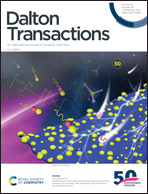Adaptive aromaticity in 16-valence-electron metallazapentalenes†
Abstract
According to Hückel's and Baird's rules, cyclic species are generally aromatic only either in the lowest singlet state (S0) or in the lowest-lying triplet ππ* excited state (T1). Thus, species with aromaticity both in S0 and T1 states (termed as adaptive aromaticity) are particularly rare. Herein, we carry out density functional theory (DFT) calculations to examine the aromaticity of 16e metallapentalenes containing heteroatoms (N, O). Interestingly, metallazapentalenes show adaptive aromaticity whereas metalloxapentalenes display nonaromaticity in the S0 and T1 states, which is supported by structural, magnetic, and electronic indices. In addition, a series of metallazapentalenes containing strong σ- or π-donor ligands are predicted to achieve adaptive aromaticity. Our findings expand the family of adaptive aromatics significantly, inviting experimental chemists to realize more hetero-metallapentalenes with adaptive aromaticity.



 Please wait while we load your content...
Please wait while we load your content...